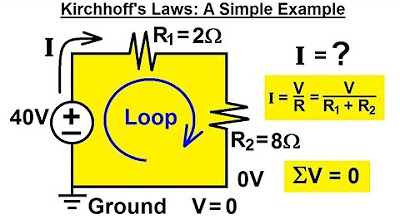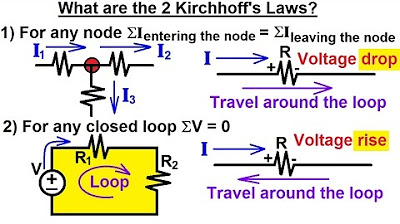Kirchhoff's Law Part 1
Summary
TLDRThis video explains Kirchhoff's laws, focusing on the junction rule and the loop rule. The junction rule states that the sum of currents entering a junction equals the sum leaving, while the loop rule requires that the sum of potential differences in a closed loop is zero. Through an example circuit with multiple batteries and resistors, the presenter defines key concepts like junctions and branches, assigns currents to each branch, and demonstrates how to apply both rules to solve for unknown currents. The tutorial emphasizes the importance of consistent directional choices for accurate circuit analysis.
Please replace the link and try again.
Q & A
What are Kirchhoff's two main laws?
-The two main laws are the Junction Rule (or Current Rule) and the Loop Rule (or Voltage Rule).
What does the Junction Rule state?
-The Junction Rule states that the sum of the currents entering a junction must equal the sum of the currents leaving that junction.
How is the Loop Rule defined?
-The Loop Rule states that the sum of all potential differences (voltages) around a closed loop must equal zero.
What is the difference between a junction and a branch in a circuit?
-A junction is where two or more wires connect, while a branch is any connection that links two junctions.
How do you label currents in a circuit with multiple branches?
-Each branch gets its own current label, such as i1, i2, and i3, which are assigned random directions initially.
What is the significance of choosing current directions randomly?
-Choosing current directions randomly allows for analysis, and the correctness can be determined after calculations.
What equation represents the relationship between voltage, current, and resistance?
-The equation is V = IR, where V is voltage, I is current, and R is resistance.
How do you determine the sign of voltage across batteries and resistors?
-For batteries, going from negative to positive is a positive voltage, and for resistors, if you follow the current direction, it’s a negative voltage.
Why is it sufficient to use one Junction Rule equation for some circuits?
-In circuits with two main chunks, the equations may provide the same information, making one equation sufficient.
How many loop rule equations are needed based on the number of variables?
-You need as many loop rule equations as there are variables; if there are three variables, three equations are needed.
Outlines

This section is available to paid users only. Please upgrade to access this part.
Upgrade NowMindmap

This section is available to paid users only. Please upgrade to access this part.
Upgrade NowKeywords

This section is available to paid users only. Please upgrade to access this part.
Upgrade NowHighlights

This section is available to paid users only. Please upgrade to access this part.
Upgrade NowTranscripts

This section is available to paid users only. Please upgrade to access this part.
Upgrade NowBrowse More Related Video

Capacitors and Kirchhoff: Crash Course Physics #31

KVL and KCL (Circuits for Beginners #11)

Electrical Engineering: Basic Laws (11 of 31) Kirchhoff's Laws: A Medium Example 2

Electrical Engineering: Basic Laws (9 of 31) Kirchhoff's Laws: A Simple Example

Electrical Engineering: Basic Laws (8 of 31) What Are Kirchhoff's Laws?

Lecture5: Single Loop Circuits
5.0 / 5 (0 votes)